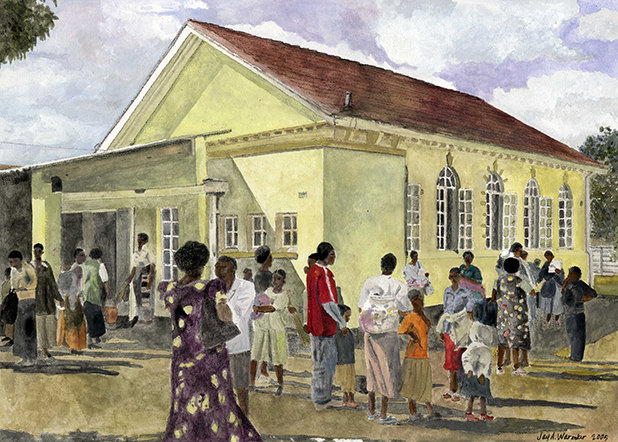 Exterior View (2005), 15” x 11” Watercolor, Jay A. Waronker
Exterior View (2005), 15” x 11” Watercolor, Jay A. Waronker
ZIMBABWE
Kwekwe (Formerly Que Que) Hebrew Congregation Synagogue (Dating to the Early 1940s) |
|

Interior View (2005), 15” x 11” Watercolor, Jay A. Waronker
|
Along the main road that connects Bulawayo in the south with northern Harare is Zimbabwe’s Midlands, the central region of the country once contained prime farmland that produced a variety of bountiful crops and products enough to fed the country and region. Within the Midlands are three small cities that for some decades had Jewish communities: Gweru, Kwekwe, and, Kadoma. The Highlands city of Mutare, to the east near the border with Mozambique, also had a Jewish community. For years these communities managed by conducting prayer services in private homes or temporary facilities, but by the 1930s to early 1940s, except for Mutare, they were large and sustainable enough to need proper synagogues. In Kwekwe, a modest one was constructed on Burma Road in a quiet district just southeast of town. Made up of a foyer, office space, support areas, and a 34’ x 52’ sanctuary, the painted stucco-clad masonry building with its gabled roof served its congregation of Jews for some four decades.
At the time of this painting, the interior of the former synagogue had changed little from its original design: a rectangular space with long rows of pews, the niche for the ark was now removed and above it a framed image of Christ, large metal casement windows with rounded arched-top along the painted plaster walls, and a ceiling with batten strips dividing the flat panels. The original lighting had been replaced by fixtures with naked fluorescent tubes.
By the 1980s, the Jewish population in Kwekwe had so declined that the building was no longer needed. In good condition and conveniently located, it was sold by the Jews to the local Hindu community who used it for some years for their communal purposes. Eventually the Hindus outgrew it and built a more proper temple on adjacent property. The former synagogue was next rented to a black African church, and they were lovingly using the building at the time this watercolor was completed. When the artist of this painting visited the building on a Sunday afternoon, he was first graciously invited by a leader of the congregation to come inside to participate in a lively service. After the service, while the building was being cleaned by women of the congregation, Waronker was permitted to document the former synagogue before he was driven by church members to catch a very crowded bus onward to Harare.
